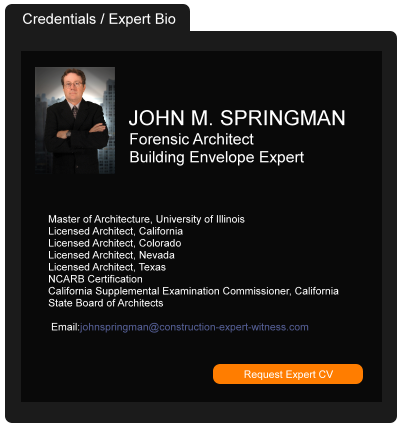Condo Buyers Seek to Void Sale over Construction Defect Lawsuit
November 07, 2012 —
CDJ STAFFA Michigan couple seeks to void their purchase of a condo in Texas after discovering that the complex was undergoing a construction defect lawsuit. ABQ Journal reports that Charles M. Lea and Olga Y. Ziabrikova said that they would not have purchased the condo if they had known the association was already alleging construction defects. The condo association discovered the defects “by at least late 2010,” according to the suit. The couple bought their condo in August 2011 and heard of the defects only in March 2012.
The couple notes that no one involved with the sale informed them of the construction defect complaints. The community association’s lawsuit states that problems have lead to $2.5 million in damages. The developer, Vegas Verde Condo Partners, have filed a general denial of the construction problems.
Read the court decisionRead the full story...Reprinted courtesy of
A Behind-the-Scenes Look at Substitution Hearings Under California’s Listing Law
March 04, 2019 —
Garret Murai - California Construction Law BlogThe next case, JMS Air Conditioning and Appliance Service, Inc. v. Santa Monica Community College District, 2nd District Court of Appeal, Case No. B284068 (December 17, 2018), provides an interesting behind-the-scenes look at substitution hearings under the Subletting and Subcontracting Fair Practices Act.
The Subletting and Subcontracting Fair Practices Act
- The Subletting and Subcontracting Fair Practices Act (Public Contract Code Section 4100 et seq.), also commonly referred to as the “Listing Law,” requires that prime contractors on state and local public works projects “list” the following subcontractors in their bids:
- Subcontractors who are anticipated to perform work with a value in excess of 0.5% of the prime contractor’s total bid; and
Subcontractors, on street, highway and bridge projects, who are anticipated to perform work with a value in excess of the greater of: (a) 0.5% of the prime contractor’s total bid; or (b) in excess of $10,000.
Read the court decisionRead the full story...Reprinted courtesy of
Garret Murai, Wendel RosenMr. Murai may be contacted at
gmurai@wendel.com
Energy Efficiency Ratings Aren’t Actually Predicting Energy Efficiency
February 07, 2022 —
Ryan Hesketh - BloombergThere’s a secret dogging British buildings with some of the most coveted environmental ratings: On paper they’re green, but scratch the surface and they’re red hot. Buildings that have received the highest rating in the U.K. — an A Energy Performance Certificate — use more energy than some of their peers rated C, D, E or even F.
This disparity between how buildings are designed and what their actual emissions are is widespread in the U.K., according to recent findings from the Better Buildings Partnership, which analyzed 2020 self-reported energy data provided for more than 1,100 commercial properties.
It found that commercial buildings regularly use more energy than their sterling eco-friendly labels would suggest. In fact, the analysis finds, the ratings are so far off that the median energy intensity for all B-rated buildings is higher than for C-rated buildings.
Read the court decisionRead the full story...Reprinted courtesy of
Ryan Hesketh, Bloomberg
A Homeowner’s Subsequent Action is Barred as a Matter of Law by way of a Prior “Right to Repair Act” Claim Resolved by Cash Settlement for Waiver of all Known or Unknown Claims
February 26, 2015 —
Richard H. Glucksman, Esq., Jon A. Turigliatto, Esq., and David A. Napper, Esq. – Chapman Glucksman Dean Roeb & Barger BulletinDavid Belasco v. Gary Loren Wells et al. (2015) B254525
OVERVIEW
In a decision published on February 17, 2015, the Second District Court of Appeal made clear that settlement agreements containing waivers of unknown claims in connection with a construction of a property, absent fraud or misrepresentation, will be upheld. In brief, the homeowner plaintiff had made a claim against the builder pursuant to California Code of Civil Procedure Section 896 (“Right to Repair”) and settled for a cash payment and obtained a Release of all Claims including for all known and unknown claims. The court held that homeowner’s subsequent construction defect claim was barred pursuant to the terms and conditions of the earlier release.
DISCUSSION
Plaintiff and Appellant, David Belasco ("Belasco"), purchased a newly construction home in Manhattan Beach from builder Gary Loren Wells ("Wells"). Two years after purchasing the property, Belasco filed a Complaint for construction defects, which eventually resulted in settlement between the parties. The settlement agreement included a California Civil Code Section 1524 waiver of all known or unknown claims with the word "claims" defined in part as “any and all known and unknown construction defects." Six years later in 2012, Belasco filed a Complaint alleging a claim, amongst others, that the defective and leaky roof breached the statutory warranty on new construction under California Civil Code section 896 ("Right to Repair Act").
Relying on San Diego Hospice v. County of San Diego (1995) 31 Cal.App.4th 1048, Wells and Wells' surety, American Contractors Indemnity Company (collectively "Wells"), filed a motion for summary judgment contending that the 2012 action was barred by the settlement of Belasco’s prior Complaint against Wells for construction defects to his home. When the trial court ruled in favor of Wells, Belasco appealed. Belasco, a patent attorney, made the following contentions:(1) the general release and section 1542 wavier in the settlement agreement for patent construction defects is not a "reasonable release" of a subsequent claim for latent construction defects within the meaning of section 929 and the “Right to Repair” Act; (2) a reasonable release can only apply to a "particular violation" and not to a latest defect under the language of section945.5, subdivision (f), and the settlement was too vague to be valid because it does not reference a "particular violation;" (3) section 932 of the California Civil Code specifically authorizes an action on "[s]subsequently discovered claims of unmet standards;" (4) public policy prohibits use of a general release and section 1542 waiver to bar a subsequent claim for latent residential construction defects; and (5) a genuine issue of material fact exists concerning Belasco's fraud and negligence claims that would have voided the settlement pursuant to section 1668.
Pursuant to the "Right to Repair Act" Section 929 subsection (a), a builder can make a cash offer in lieu of a repair and the homeowner is free to accept or reject such offer. Section 929subsection (b) goes on to state that
"[t]he builder may obtain a reasonable release in exchange for the cash payment. The builder may negotiate the terms and conditions of any reasonable release in terms of scope and consideration in conjunction with a cash payment under this chapter."
The Second District Court of Appeal ruled that the prior cash settlement, with a release and section 1524 wavier, was a "reasonable release" under the language of California Civil Code Section 929.
On multiple occasions, the Court noted that Belasco is an attorney and was represented by an attorney during the negotiation of the settlement agreement. By executing the agreement with express language regarding what claims were to be release, Belasco released Wells of "any and all claims" due to "any and all known and unknown construction defects." The Court reasoned that because Belasco is an attorney in his own right, he should have understood the import of the Section 1542 waiver and had the opportunity to reject or revise the settlement agreement prior to binding himself to it. The Court further found that the agreement "could not have been more clear" regarding the waiver of all unknown and known construction defect claims and therefore was not vague. Belasco's additional contentions were found to be without merit because Belasco availed himself of the statutory remedy of a cash settlement in lieu of repairs and voluntarily entered into a negotiated settlement agreement. Lastly, Belasco failed to present any evidence regarding his misrepresentation claim.
When a homeowner files a "Right to Repair Act" claim, often it seems that only two options exist: either repair the alleged defects or go to court. However, Belasco is a reminder to builders that the "Right to Repair Act" does offer an avenue for settlement. The Second District Court of Appeal presented a clear, unqualified opinion regarding the validity and enforceability of settlement agreements releasing all known or unknown construction defects in a single family home case. The Court will hold parties to the settlements they agree to. This is especially so when one of the parties is an attorney and provides deposition testimony expressly acknowledging that he understood the scope of the agreement. Attorneys for builders should always include a waiver of all known and unknown claims, which pursuant to Belasco and San Diego Hospice, will ensure that any future claims at the property will be effectively barred by the terms of the settlement agreement.
Reprinted courtesy of Chapman Glucksman Dean Roeb & Barger attorneys
Richard H. Glucksman,
Jon A. Turigliatto and
David A. Napper
Mr. Glucksman may be contacted at rglucksman@cgdrblaw.com
Mr. Turigliatto may be contacted at jturigliatto@cgdrblaw.com
Mr. Napper may be contacted at dnapper@cgdrblaw.com
Read the court decisionRead the full story...Reprinted courtesy of
Graham & Who May Trigger The Need To Protest
December 23, 2023 —
Hugo Fraga - Ahlers Cressman & Sleight PLLCOn May 30, 2023, the Washington Court of Appeals, Division I, issued a decision that appears to expand a contractor’s obligation with respect to WSDOT notice and claim procedures. In
Graham Contracting, Ltd. v. City of Federal Way, No. 83494-1-I, 2023 WL 3721171 (Wash. Ct. App. May 30, 2023) (Unpublished), the Court held that under the 2016 WSDOT Standard Specifications for Road, Bridge, and Municipal Construction (“Standard Specifications”), a Contractor must protest the actions of not only the “Engineer” but also the actions of any person or organization acting on behalf of the Owner.
This case arises out of a public construction contract in which Graham Contracting Ltd (“Graham”) built a multi-million dollar roadway improvement for the City of Federal Way along a stretch of Pacific Highway. The appeal was from the trial court’s granting of the City’s motion for summary judgment to dismiss claims by Graham for extra time and money due to delays and impacts to Graham’s construction of the Project.
Read the court decisionRead the full story...Reprinted courtesy of
Hugo Fraga, Ahlers Cressman & Sleight PLLCMr. Fraga may be contacted at
hugo.fraga@acslawyers.com
Massachusetts Couple Seek to Recuse Judge in Construction Defect Case
September 30, 2011 —
CDJ STAFFAfter seeing their $1 million jury award overturned on appeal by a judge who called the award “against the weight of evidence and likely due to misapprehension, confusion or passion,” Kathryn and Christian Culley are seeking to have him removed from the case. The Massachusetts Supreme Judicial Court has rejected their claim.
The Culleys claim that Judge Thomas R. Murtagh’s decision was influence by him membership in the Andover Country Club which is represented by the opposing counsel in their construction defect case. Justice Margot G. Botsford had denied the Culley’s request, ruling that they had other remedies available to them.
The SJC noted in their ruling that if the Culleys are alleging judicial misconduct a request must be made to the Commission on Judicial Conduct. Their lawyer plans to file a new motion for recusal with the SJC.
Read the full story…
Read the court decisionRead the full story...Reprinted courtesy of
SIG Earnings Advance 21% as U.K. Construction Strengthens
August 13, 2014 —
Benjamin Katz – BloombergSIG Plc (SHI) earnings surged 21 percent in the first half as the distributor of building products benefited from a strengthening recovery in the U.K. housing market as well as procurement savings.
Underlying operating profit rose to 47.8 million pounds ($80 million) from 39.6 million pounds a year earlier, the Sheffield, England-based company said in a statement today. Sales in the U.K. and Ireland from continuing operations climbed 14 percent to 650 million pounds, offsetting flat revenue in continental Europe.
“Trading conditions in the U.K. have continued to gather momentum, led by the revival in the housing market,” Chief Executive Officer Stuart Mitchell said in the statement. “The group’s first-half performance and progress on its strategic initiatives provide a strong base on which to achieve its full-year expectations.”
Read the court decisionRead the full story...Reprinted courtesy of
Benjamin Katz, BloombergMr. Katz may be contacted at
bkatz38@bloomberg.net
What to Look for in Subcontractor Warranty Endorsements
February 03, 2020 —
David M. McLain – Colorado Construction LitigationWith increasing frequency in the construction defect cases we defend, we are seeing commercial general liability insurance policies with “subcontractor warranty” endorsements. Also known as contractor or subcontractor special conditions, these endorsements could have severe and negative consequences for builders that do not comply with their requirements. In researching for this article, I reviewed six different endorsements used by six different carriers, all of which contained some or all of the following requirements:
- The builder must have signed subcontract agreements with its subcontractors that require subcontractors to hold harmless, i.e., defend and indemnify, the builder for “bodily injury” or “property damage” claims caused by their negligence.
- The subcontractors must maintain their own insurance with limits equal to or greater than the limits in the builder’s own policy, with limits of at least $1 million per occurrence.
- The subcontractors’ insurance must not exclude the work being performed for the builder, e.g., the excavator’s policy cannot exclude earth movement claims, the subcontractor’s policy cannot exclude residential construction.
- The subcontractors must maintain their own workers’ compensation and/or employer’s liability insurance.
- The subcontractors must provide the builder with an endorsement or a certificate of insurance indicating that the builder has been added to the subcontractors’ insurance as an additional insured.
- The subcontractors must provide the builder with an endorsement or a certificate of insurance indicating that their insurance carriers have agreed to provide waivers of subrogation in favor of the builder.
Read the court decisionRead the full story...Reprinted courtesy of
David McLain, Higgins, Hopkins, McLain & RoswellMr. McLain may be contacted at
mclain@hhmrlaw.com


































































